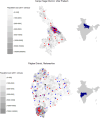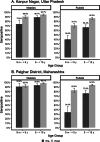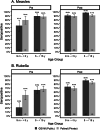Increased measles and rubella seroprevalence in children using residual blood samples from health facilities and household serosurveys after supplementary immunization activities in two districts in India
- PMID: 39552145
- PMCID: PMC11574605
- DOI: 10.1017/S0950268824001353
Increased measles and rubella seroprevalence in children using residual blood samples from health facilities and household serosurveys after supplementary immunization activities in two districts in India
Abstract
Residual blood specimens provide a sample repository that could be analyzed to estimate and track changes in seroprevalence with fewer resources than household-based surveys. We conducted parallel facility and community-based cross-sectional serological surveys in two districts in India, Kanpur Nagar District, Uttar Pradesh, and Palghar District, Maharashtra, before and after a measles-rubella supplemental immunization activity (MR-SIA) from 2018 to 2019. Anonymized residual specimens from children 9 months to younger than 15 years of age were collected from public and private diagnostic laboratories and public hospitals and tested for IgG antibodies to measles and rubella viruses. Significant increases in seroprevalence were observed following the MR SIA using the facility-based specimens. Younger children whose specimens were tested at a public facility in Kanpur Nagar District had significantly lower rubella seroprevalence prior to the SIA compared to those attending a private hospital, but this difference was not observed following the SIA. Similar increases in rubella seroprevalence were observed in facility-based and community-based serosurveys following the MR SIA, but trends in measles seroprevalence were inconsistent between the two specimen sources. Despite challenges with representativeness and limited metadata, residual specimens can be useful in estimating seroprevalence and assessing trends through facility-based sentinel surveillance.
Keywords: measles (rubeola); rubella; serology; vaccines.
Figures





Similar articles
-
Measles and rubella seroprevalence in adults using residual blood samples from health facilities and household serosurveys in Palghar District, Maharashtra, India, 2018 - 2019.Epidemiol Infect. 2024 Dec 6;152:e161. doi: 10.1017/S0950268824001389. Epidemiol Infect. 2024. PMID: 39639481 Free PMC article.
-
Evaluating the effect of measles and rubella mass vaccination campaigns on seroprevalence in India: a before-and-after cross-sectional household serosurvey in four districts, 2018-2020.Lancet Glob Health. 2022 Nov;10(11):e1655-e1664. doi: 10.1016/S2214-109X(22)00379-5. Lancet Glob Health. 2022. PMID: 36240831 Free PMC article.
-
Diagnostic Accuracy of Dried Blood Spots Collected on HemaSpot HF Devices Compared to Venous Blood Specimens To Estimate Measles and Rubella Seroprevalence.mSphere. 2021 Aug 25;6(4):e0133020. doi: 10.1128/mSphere.01330-20. Epub 2021 Jul 14. mSphere. 2021. PMID: 34259557 Free PMC article.
-
Age-specific prevalence of IgG against measles/rubella and the impact of routine and supplementary immunization activities: A multistage random cluster sampling study with mathematical modelling.Int J Infect Dis. 2024 Jul;144:107053. doi: 10.1016/j.ijid.2024.107053. Epub 2024 Apr 17. Int J Infect Dis. 2024. PMID: 38641317
-
Evaluation of nationwide supplementary immunization in Lao People's Democratic Republic: Population-based seroprevalence survey of anti-measles and anti-rubella IgG in children and adults, mathematical modelling and a stability testing of the vaccine.PLoS One. 2018 Mar 29;13(3):e0194931. doi: 10.1371/journal.pone.0194931. eCollection 2018. PLoS One. 2018. PMID: 29596472 Free PMC article.
Cited by
-
Age-Specific Seroprevalence of Measles, Mumps, and Rubella IgG across All Age Groups in Chonburi Province, Thailand after the Coronavirus Disease 2019 Pandemic.Am J Trop Med Hyg. 2025 Apr 8;112(6):1385-1390. doi: 10.4269/ajtmh.25-0005. Print 2025 Jun 4. Am J Trop Med Hyg. 2025. PMID: 40203819
References
-
- Cutts FT and Hanson M (2016) Seroepidemiology: An underused tool for designing and monitoring vaccination programmes in low- and middle-income countries. Tropical Medicine & International Health 21(9), 1086–1098. - PubMed
-
- Mutembo S, et al. (2018) Integrating blood collection within household surveys: Lessons learned from nesting a measles and rubella serological survey within a post-campaign coverage evaluation survey in Southern Province, Zambia. American Journal of Tropical Medicine and Hygiene 99(6), 1639–1642. - PMC - PubMed
MeSH terms
Substances
Grants and funding
LinkOut - more resources
Full Text Sources
Medical

